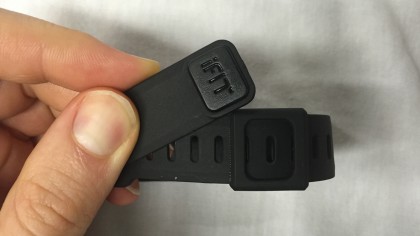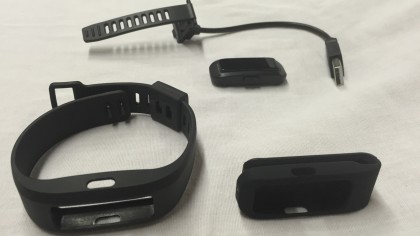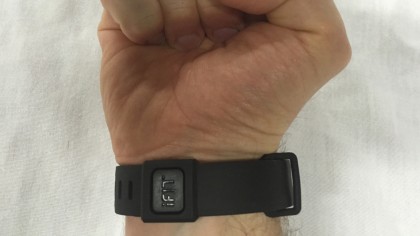Why you can trust TechRadar
The iFit Active is compatible with your iPhone 4S and above, iPod Touch fifth-gen and above, and Android 4.3 devices and higher. You can download the iFit Track app in Apple's App Store or on Google Play.
The iFit Active can't operate unless you first sync it via Bluetooth with the iFit Track app. The data that is stored in your iFit Active will sync up and log itself into the app, keeping a detailed record of each day's activities.

After setting up an iFit account, you'll enter your height, weight, and gender and be able to set goals for the number of steps, distance, calories burned and consumed, net calories, and sleeping time. The tracker pod will show a percentage out of 100 next to each logged number.
The app displays a wheel with dots that light up based on your calorie input and output. Your net calories display in the middle, with a list of three items below documenting a progression line of calories consumed, steps taken, and hours of sleep.
Eating a complex meal that you might otherwise be unaware of for its nutritional values can be recorded directly into the app. The iFit Active has a catalog of various popular food items that you can choose from.
This isn't always 100% accurate, since exact foods won't always match in concise nutritional values; through confident guesstimating, you'll be able to find the appropriate meal – you can always adjust the serving size too.
Each time you document a referenced meal, the iFit Track records the amount of fiber, unsaturated fat, other carbs, protein, sugar, saturated fat, sodium, and cholesterol counts. Each attribute of nutritional value will be tallied up by percentage based on the USDA's daily recommendation (e.g. "30% fiber? Have more." or "215% Sugar? Hold on, too many is not good."), keeping track of your daily intake.

You're also able to input various exercising activities directly in the iFit Track app. The "Log Workout" gives you inputs for your activity type, end time, duration, and calories burned. Unfortunately, this is more arbitrary than meal logging because there's no preset to estimate burned calories with their associated exercises.
The app also connects you to not only a dashboard and stats, but includes a friend's list for those with an iFit Active, a calendar with a detailed progression chart of every bit of recorded data, a newsfeed, and a leaderboard.
Battery life
The best attribute (and strongest selling point) of the iFit Active is its immense battery life. Under moderate usage, and conservative estimations, the iFit can last about two full weeks.
After a full week and a half of testing without ever turning it off or charging, the iFit was still kicking with a 30 percent charge. Calculated, this would mean the iFit still had about five to six days of battery life left.

Consider the conditions: My workout routine included 10 hours weightlifting at the gym every week along with light walking. Through the iFit Track app, I logged in my daily meal intakes, then synced it immediately with the iFit so it could display the correct data. Whenever a moment of exercise or diet occurred, I made sure to log it. I never took the iFit Active off unless showering or sleeping - virtually every step I took was recorded.
Where most companies might overstate their product's claims, the iFit Active underestimates its battery charges to last approximately "5 to 7 days."
Some electronics, like smartphones, are never turned off unless there's an immediate lack of outlets. The iFit takes about six hours to fully charge, and lasts long enough to reconsider the fairness of its price tag.
We liked
Though putting the tracker pod into the wristwatch casing is a bit tedious, it highlights its durability. Most collapsible gear doesn't feel sturdy once joined together, but the iFit Active always felt intact whether it was sleeved in its wristband, snug in the clip mold, or strapped in for charging.
It's a breath of fresh air that iFit Active isn't an overly complicated piece of wearable hardware that's trying to be everything. Simply inputting variables of data for calories in and calories out as well as automatically recording my steps seemed practical enough to come off as an introductory fitness tracker.
We disliked
The app wasn't reliable when syncing with the iFit Active. After the first week, the app notified me that it "Cannot Sync" and I had to give it a hard reset. After doing so, I got the same message, and again, found myself repeating the same instructions of a hard reset and then re-syncing. I gave up after the fifth time. All the data that was stored on the iFit Active over the day was now gone.
The $79 (£64.30, AU$96.49) price tag is absolutely absurd and completely unjustifiable. There are already fitness trackers on the market for $17.77 (£14.47, AU$21.70) like the iBody Oled, or the Misfit Fitness tracker for $49.99 (£40.70, AU$61.06) that deliver a lot of the same or better features as the iFit Active. Essentially the rule of thumb is that you get what you pay for, but the iFit Active is willing to make that exception.
On a lesser note, if you happen to be wearing the iFit Active outside during the daylight, it's virtually impossible to read the display. The LED light is best viewed in darker settings.
Final verdict
The iFit Active is an appropriate introductory fitness tracker in the developing market of new wearable technology, but it's the high price and sync malfunctions that ultimately bury it in its grave.
If ICON Health & Fitness, Inc. decided to scale down the retail price to be more affordable as well as fix a few bugs, the iFit Active could immensely enhance its brand as a stand-alone substitute opposed to other more overwhelming and complex fitness trackers.
For $99 (£80.58, AU$121.05) extra, you can get your hands on the well-received Razer Nabu, a sophisticated fitness tracker with a vibrant digital display that can let you know when you receive calls, texts, e-mails, and social media notifications.
The pattern of inconsistencies with the company's official estimate on battery life, a highly marked up retail price, and a lack of anticipation for sync malfunctions sadly reflects on the product in itself. A quick Amazon search and many users are also experiencing problems with syncing.
The overall feeling when dealing with the iFit Active was in itself a workout of my patience. I want it to be good, because it can be good, but it's so unfortunate how unprepared it was, as if the company was unaware of the product it was making and what it has to compete with.
